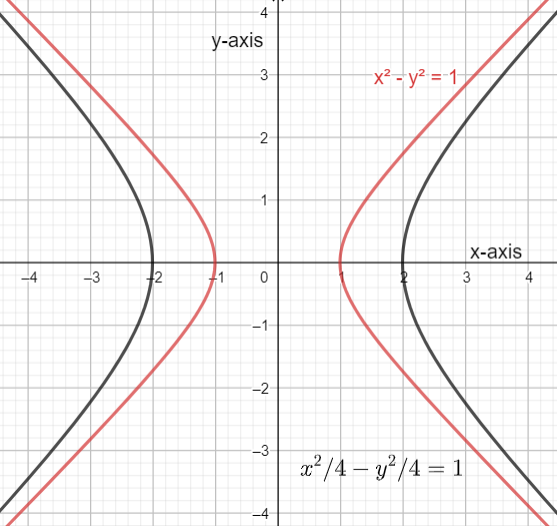Question
Question: Let P (6, 3) be the point on the hyperbola \(\dfrac{{{x}^{2}}}{{{a}^{2}}}-\dfrac{{{y}^{2}}}{{{b}^{2}...
Let P (6, 3) be the point on the hyperbola a2x2−b2y2=1. If the normal at the point P intersects at the X-axis at (9, 0), then the eccentricity of the hyperbola is
(a) 25
(b) 23
(c) 2
(d) 3
Solution
Hint: We use the normal equation of hyperbola which is given by a2y1(x−x1)+b2x1(y−y1)=0 where x1 and y1 are the coordinates of point P (6, 3).
Complete step-by-step answer:
The equation of hyperbola a2x2−b2y2=1 is the equation of family of hyperbolas. By considering a=b=1 (in red colour) and substituting a=b=2 (in black colour) in the equation we get the following diagram.

As we can see that the equation of hyperbola is given and since the point P(6,3) lies on this equation so we can substitute the value P(6,3) in equation of hyperbola as such in place of x and y in a2x2−b2y2=1.
Thus we get,
a2(6)2−b2(3)2=1a236−b29=1
Now we use the normal equation of hyperbola which is a2y1(x−x1)+b2x1(y−y1)=0 and substitute the value of P to it. This implies 3a2(x−x1)+6b2(y−y1)=0....(i)
This implies that 3a2(x−x1)+6b2(y−y1)=0
Proceeding further we get,
3a2(x−x1)+6b2(y−y1)=03a2(x−6)+6b2(y−3)=0(3a2x−18a2)+(6b2y−18b2)=0(3a2x−18a2)=−(6b2y−18b2)
This further implies 3a2x−18a2=−6b2y+18b2
As it is clear from the question that the normal at the point P intersects at the X-axis at (9, 0), so we can substitute the point (9, 0) in equation (i) in place of (x,y) . Thus we have,
3a2(9)−18a2=−6b2(0)+18b23a2(9)−18a2=18b227a2−18a2=18b29a2=18b2a2=2b2
This gives the simplest form of the equation and that is a=2b....(ii)
Now we use the formula of eccentricity of hyperbola which is e=aa2+b2....(iii) where e is called eccentricity of hyperbola.
Now we substitute equation (ii) in (iii) and we get,
2b(2b)2+b2=2b2b2+b22b(2b)2+b2=2b3b22b(2b)2+b2=2b3b
Now we cancel b from numerator and denominator. This implies 2b3b=23
Hence the correct option is (b).
Note: By substituting the point only, we can get the simplest form of the equation instead of solving without substituting. The substitution in the right equation will lead to the desired result. Squaring a negative sign will imply a positive sign. Moreover, try to cancel common terms in numerator and denominator to get a simple form. This results in reaching the right answer.
